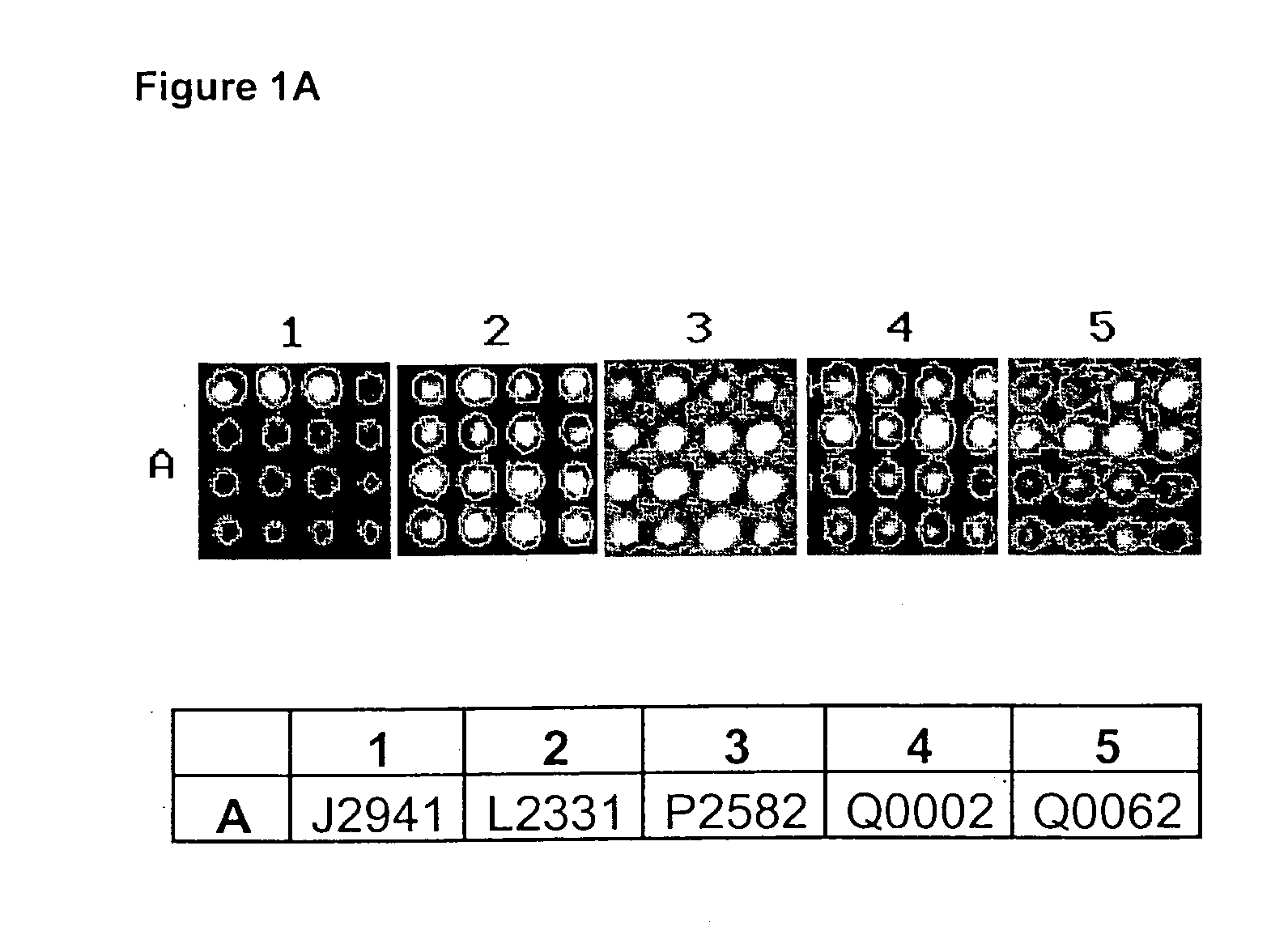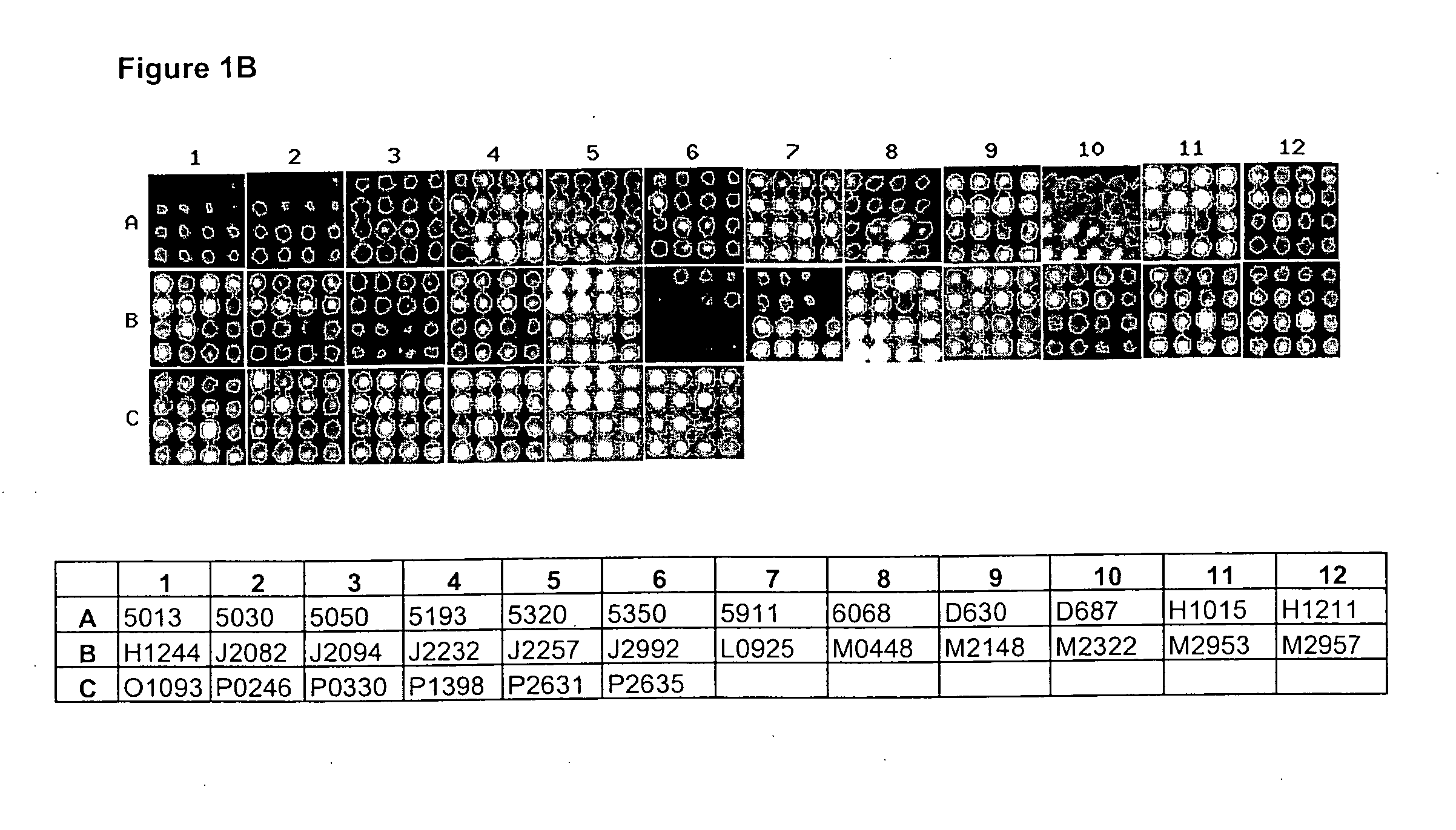Lung cancer specific gene products: their coding sequence, their antibodies and their use in diagnostic, therapeutic and disease management of lung cancer
- Summary
- Abstract
- Description
- Claims
- Application Information
AI Technical Summary
Benefits of technology
Problems solved by technology
Method used
Image
Examples
Example
[0091] In the immunodetection analysis detailed in Example 3 and described in a number of preferred embodiments of the present invention, the detection of relevant gene products or targets identified within a complex biological mixture (i.e. antibody-antigen complexes) is preferably performed by way of a chemiluminescent reaction, although protocols based on other labeling and detection systems, such as alkaline-phosphatase, biotin-streptavidine, or fluorescence systems can also be successfully used within the scope of the present invention. Antigen-antibody or target-identifier signals are captured by a charge-coupled device (CCD) camera, processed and quantified by a specialized software, and data analyzed as described in Example 5 and 6.
[0092] In a preferred embodiment of the present invention (FIGS. 1A to 1D) antibodies of the present invention are reacted on lung cancer specimens by means of the matrix protein array analysis. Antibodies are used to examine the differential exp...
Example
Example 1
[0126] Polynucleotide Sequences
[0127] Polynucleotides encompassed by this invention are listed in Table 4. Table 4 provides the GenBank accession number of the top one to top ten polynucieotide sequences found by BLAST searches of the public database, and sharing homology with the polynucleotides described herein. Table 4 also provides the ID No of the 159 lung cancer related antibodies of the present invention, which are associated with those polynucleotide sequences.
[0128] DNA sequences of the present invention can be isolated using standard molecular cloning, hybridization and PCR techniques (e.g. described in Sambrook et al., 1989, Molecular Cloning: A laboratory Manual, 2nd Ed., Cold Spring Harbor Laboratory Press, Cold Spring Harbor, N.Y.) together with the sequence information provided in Table 5. DNA clones can be prepared for sequencing via conventional alkaline lysis method.
[0129] DNA sequencing is performed using an ABI 377 automated DNA sequencer (Applied Bi...
Example
Example 2
[0130] Protein Sample Preparation
[0131] Extraction of protein from tissues: Fresh or frozen tissue of human origin for the purpose of this invention, is cut off in small pieces, grounded, homogenized in a Tris-HCl, pH7.5, 50 mM, EDTA 2 mM, NaCl 100 mM, NP40 1%, and vanadate 1 mM solution containing the following protease inhibitors: PMSF, aprotinin, leupeptin at 1, 2 and 4 mM respectively. The homogenate is kept on ice for 20 minutes and centrifuged at 14,000 rpm for 15 minutes. Supernatant is transferred to a new container and the tissue pellet is resuspended, and again kept on ice for 20 minutes and centrifuged as indicated above. Supernatant is removed and added to the first one. Protein concentration is determined according to standard conditions as known to those skilled in the art. Protein solution is stored in a −80 freezer until further usage.
[0132] Preparation of serum samples: Protein concentration of serum samples is determined using standard spectrophotometri...
PUM
| Property | Measurement | Unit |
|---|---|---|
| Therapeutic | aaaaa | aaaaa |
Abstract
Description
Claims
Application Information
 Login to View More
Login to View More - R&D
- Intellectual Property
- Life Sciences
- Materials
- Tech Scout
- Unparalleled Data Quality
- Higher Quality Content
- 60% Fewer Hallucinations
Browse by: Latest US Patents, China's latest patents, Technical Efficacy Thesaurus, Application Domain, Technology Topic, Popular Technical Reports.
© 2025 PatSnap. All rights reserved.Legal|Privacy policy|Modern Slavery Act Transparency Statement|Sitemap|About US| Contact US: help@patsnap.com



